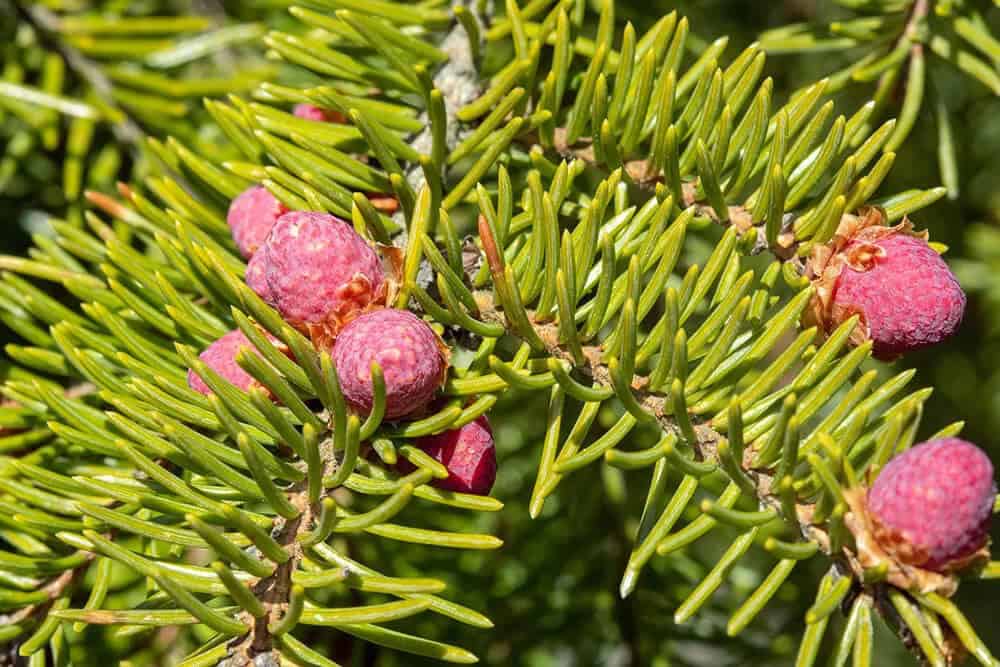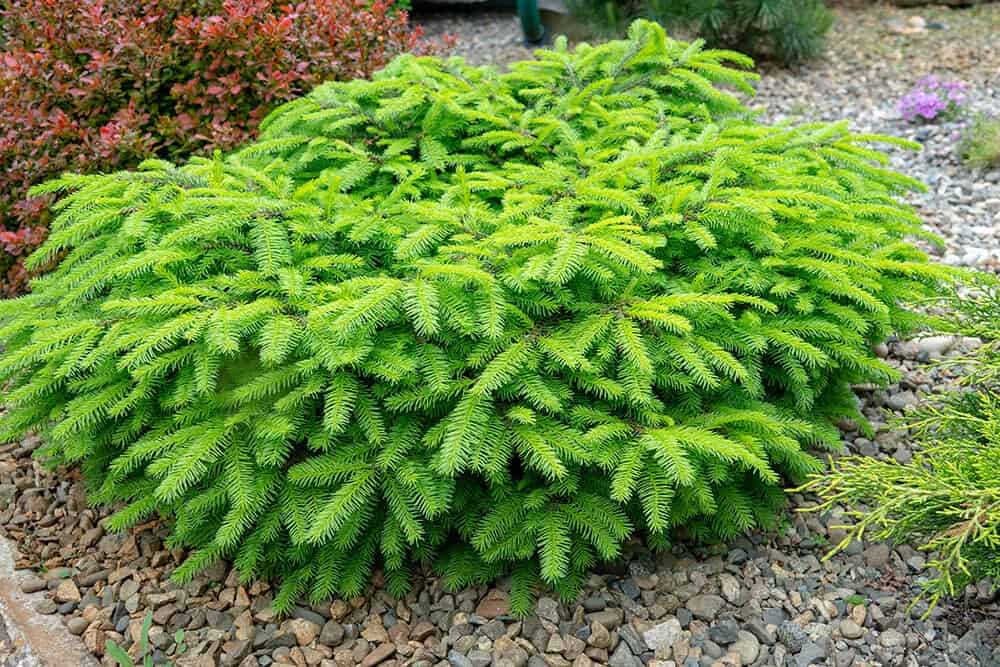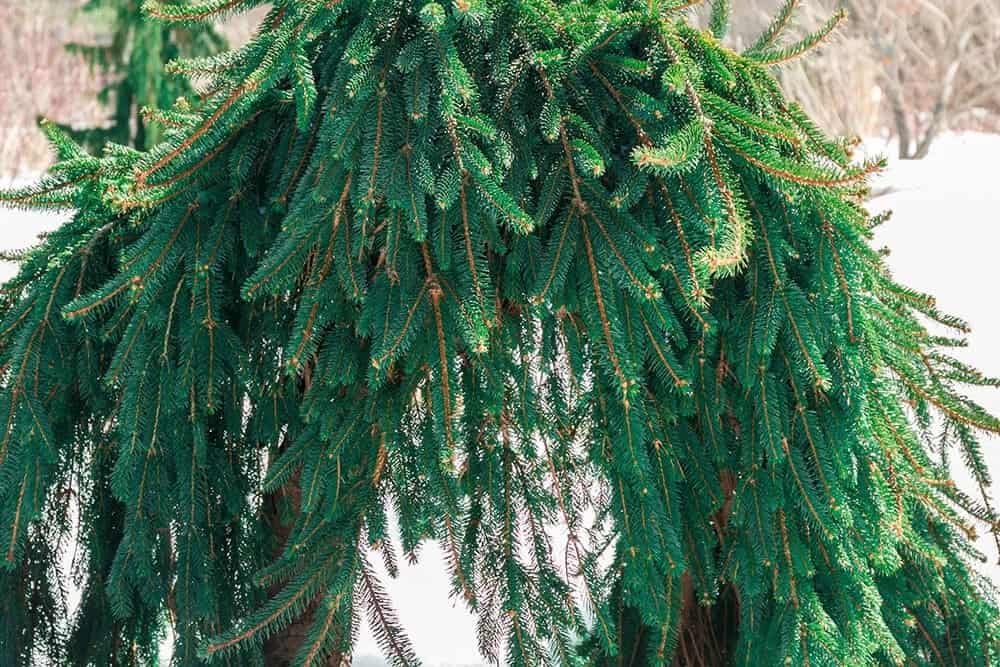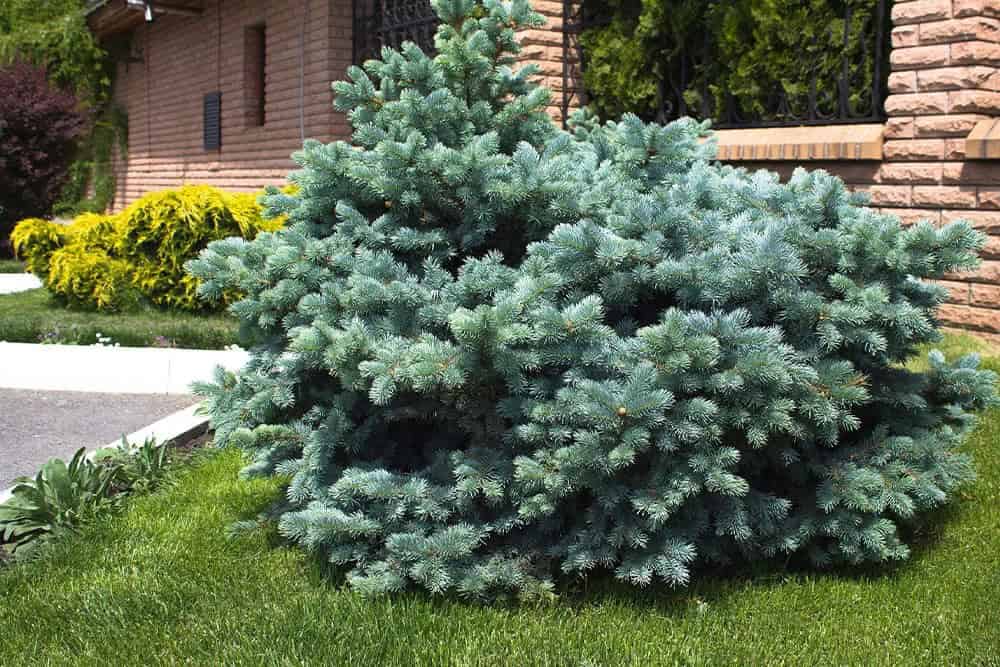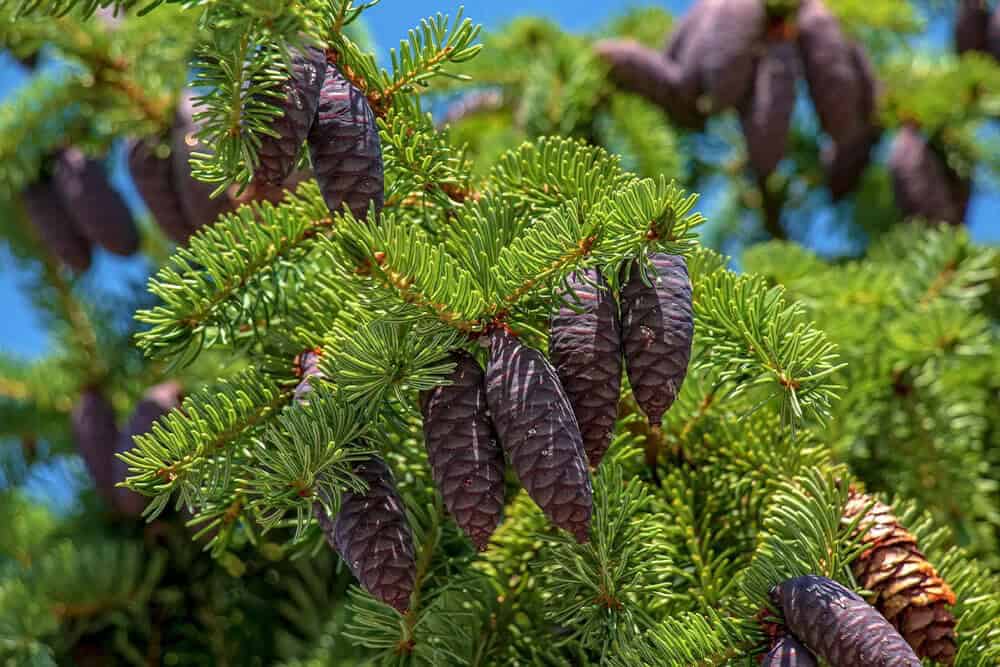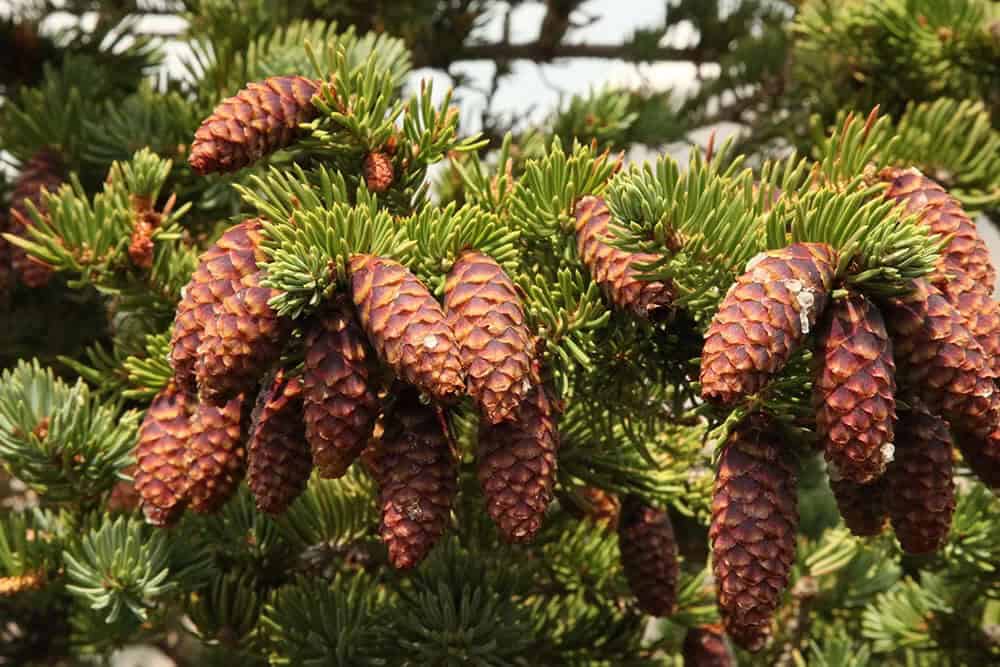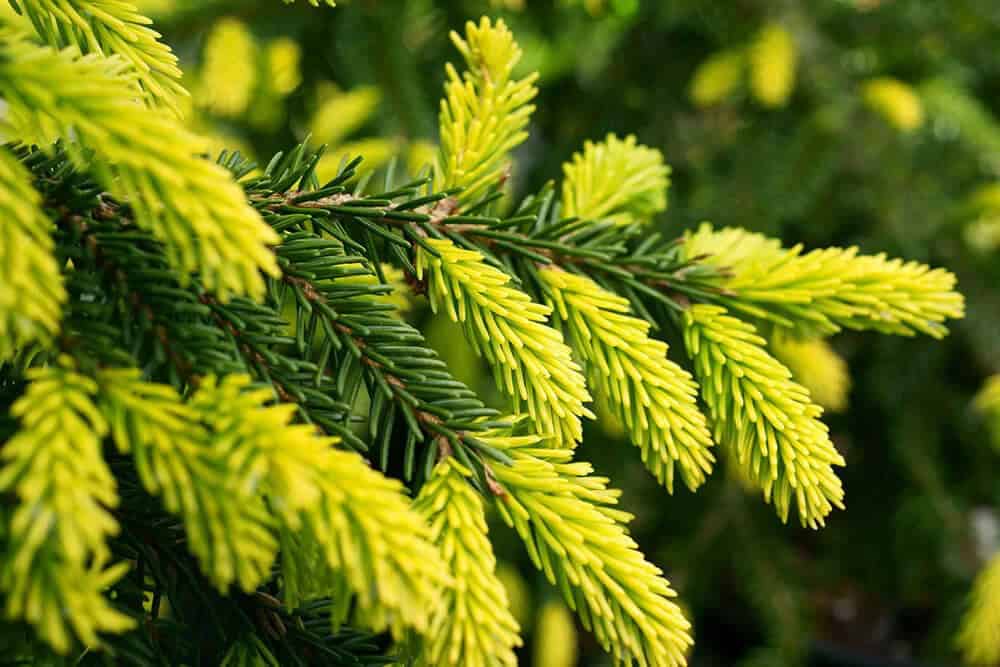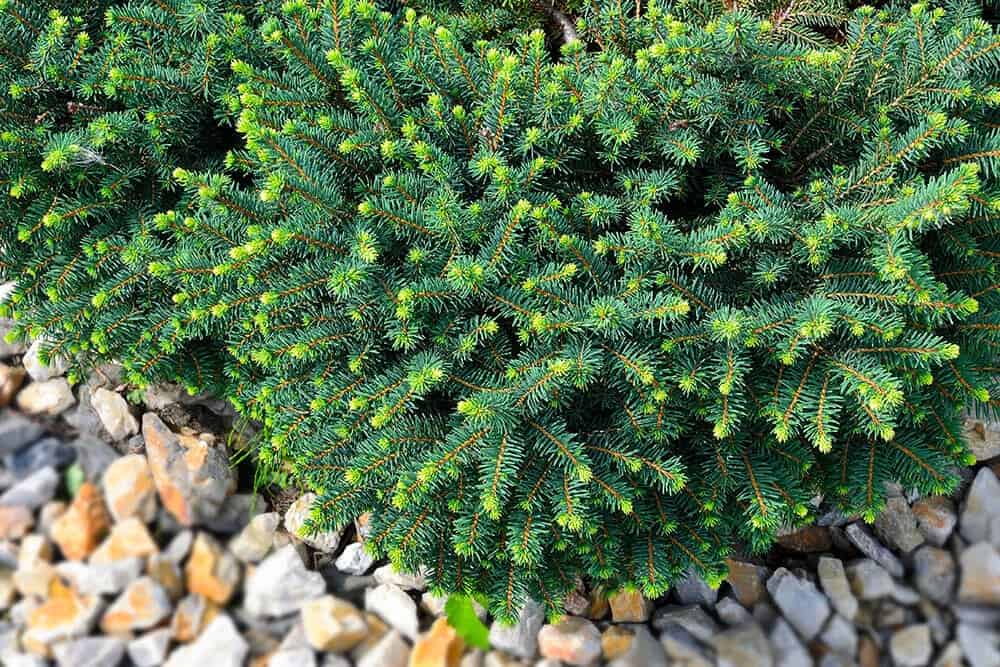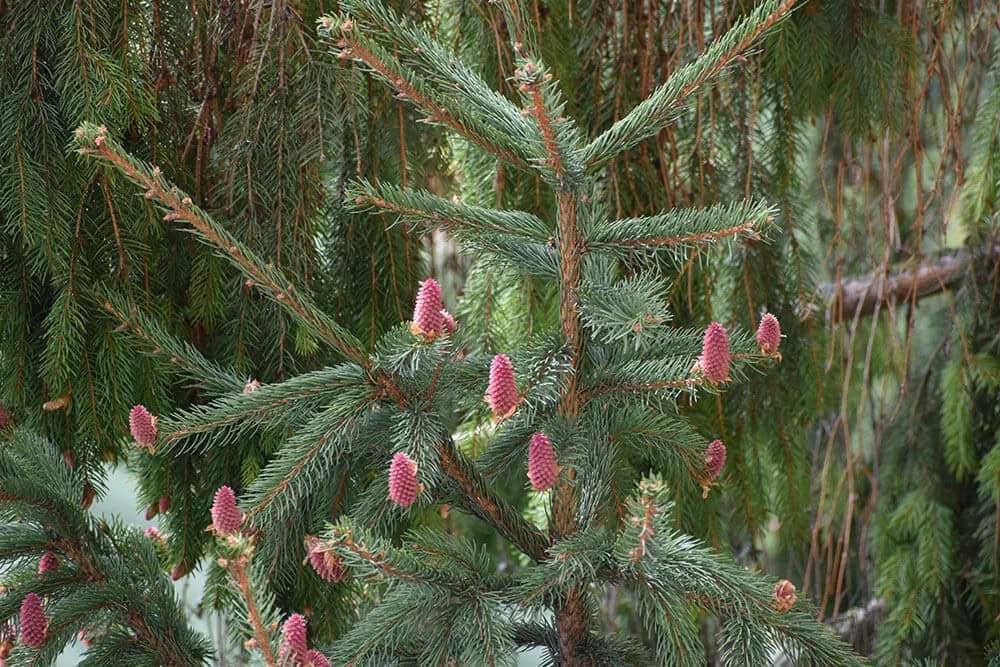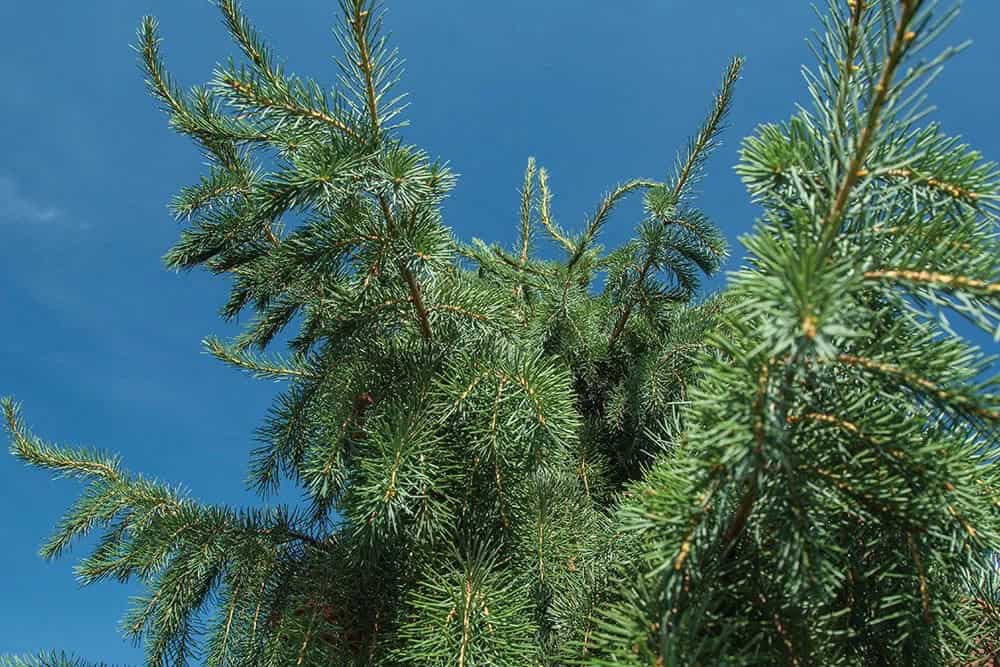Spruce trees are a popular choice for gardens, boasting unique characteristics that set them apart from other evergreen species. One of their most distinctive features is their square-shaped needles, which differ significantly from those found on juniper or cedar trees. These needle-like structures allow spruce trees to thrive in a variety of landscapes, making them a versatile option for gardeners.
In fact, spruce trees share a common ancestry with pine and fir trees, although the shape, size, and texture of their needles are distinct. For instance, pine needles tend to be longer and clustered in groups of two to five, while fir needles are typically flat and softer than those found on spruce trees. The diversity of spruce tree species is further enhanced by their ability to be cultivated into intriguing shapes, such as dwarf, weeping, and globe forms.
Additionally, the color palette of spruce needles can range from white, blue, yellow, or green, adding an extra layer of visual interest to these beautiful evergreen trees.
Key Takeaways
Spruce trees are a diverse group with 35 species found globally. These evergreen trees thrive in the northern hemisphere, where many varieties can tolerate colder climates. One key identifier for spruce trees is their unique, square-shaped needles that grow in a four-sided pattern. The cones of various spruce tree types often display vibrant colors when they’re young, adding to their visual appeal.
Furthermore, certain species exhibit fascinating shapes, such as dwarf, weeping, and globe forms, which can be a delight to behold.
Frequently Asked Questions About Types of Spruce Trees
What is the most common spruce tree?
The Colorado Blue Spruce is arguably the most sought-after spruce tree species for landscaping purposes, owing to its stunning blue-green hue, distinctive Christmas tree shape, and versatility. Its ornamental value is undeniable, making it a top choice among gardeners. Furthermore, this magnificent conifer is an excellent selection for wildlife enthusiasts, as it provides a haven for birds and other small creatures.
Moreover, the Colorado Blue Spruce offers a range of practical benefits, including privacy screening, shade provision, and wind protection.
Is spruce a pine?
Within the realm of coniferous plants, two distinct species stand out: Pine (Pinus) and Spruce (Picea). Both belong to the Pinaceae family, but their unique characteristics set them apart. As evergreen trees, they retain their foliage year-round, a trait that’s as characteristic as it is striking. One notable difference lies in their needle arrangements: Pines group theirs into clusters of 2 to 5, whereas Spruce trees feature solitary needles directly attached to branches.
Moreover, Spruce needles exhibit a distinctive square and four-sided shape, making them surprisingly pliable at the touch.
What is the difference between Serbian and Norway spruce?
Both European Spruce Trees share a common trait – their impressive height. Reaching up to 60 feet tall, they are a striking presence in any landscape. However, the similarities stop there. The Norway Spruce hails from northern Europe and Norway, while its counterpart, the Serbian Spruce, originates from Serbia. While both trees have similar hardiness levels, tolerating USDA zones 4 to 7, the key difference lies in their adaptability to environmental conditions.
The Norway Spruce is more resilient in colder climates, thriving in USDA zones 2 to 7. On the other hand, the Serbian Spruce has a unique ability to withstand pollution and hot humid weather, making it an ideal choice for urban areas where air quality can be poor.
Is it conifer or spruce?
Coniferous trees, like spruce trees, produce cones as a means of reproduction. While all types of spruce trees fit this description, not all coniferous trees are necessarily spruces. The conifer family is much broader, encompassing numerous species such as cedar, juniper, pine, fir, yew, redwood, larch, and hemlock, to name a few.
Is pine better than spruce?
When it comes to planting pines and spruces, there are numerous compelling reasons to consider doing so. Not only do these evergreen trees provide a stunning visual display that complements any surrounding foliage, but they also serve as a vital source of sustenance for local wildlife. What’s more, both pines and spruces offer year-round interest, with their dense branching providing a beautiful winter landscape.
Pines are characterized by their longer needles, which are often borne in clusters that can create a picturesque appearance. In contrast, spruce trees tend to have a denser, more compact branching structure that lends itself well to the classic Christmas tree shape. If you have the space, consider planting both and see which one becomes your new favorite.
14 Outstanding Types Of Spruce Trees For Year-Round Interest
Norway spruce (Picea abies)
Norway Spruce (Picea abies) is a highly sought-after species for its picturesque tiered branches that create an elegant symphony. This evergreen’s versatility has earned it a place as a popular choice for both Christmas trees and large landscape specimens in gardens and parks. With over 150 cultivars, Norway Spruce boasts a range of exceptional growing habits that can be showcased in various outstanding landscape features.
However, this majestic tree requires well-draining soil to thrive, as excess moisture can be detrimental to its growth. Its ideal location is in full sun, preferably within USDA hardiness zones 2 to 7. Native to northern Europe, Norway Spruce’s stunning cones hang delicately, reaching lengths of 4 to 6 inches.
Birds’ Nest Norway Spruce (Picea abies ‘nidiformis’)
Birds’ Nest Norway Spruce is a charming cultivar that boasts a compact and dwarf nature, featuring a unique squat form with an indentation on top reminiscent of a bird’s nest. This small evergreen conifer provides year-round structure and winter interest to the garden, making it an attractive addition to any landscape design.
As a slow-growing variety, Birds’ Nest Norway Spruce typically reaches 2-4 feet in height, but under ideal conditions can grow up to 8 feet across over the course of several decades – around 30 years. The tree is hardy in USDA zones 2-8 and features short, ½ inch long needles with soft, pendulous new growth that emerges in spring.
Weeping Norway Spruce (Picea abies pendula)
This weeping cultivar of Norway Spruce is certain to leave a lasting impression. With its ability to grow as a groundcover, slowly spreading over rocks and garden features in a captivating manner, it’s no wonder this specimen stands out. When supported, it can reach heights of 15 feet, making it an excellent choice for adding vertical interest to your landscape. To thrive, Weeping Norway Spruce requires well-draining soils and full sun to showcase its lovely deep green, fragrant needles.
This stunning variety is perfect as a specimen, growing well in USDA hardiness zones 3 to 7. Its unique, cascading branches will sweep outward, adding a touch of elegance to any garden or landscape.
Colorado Blue Spruce (Picea pungens)
Colorado Blue Spruce is a stunning ornamental conifer that has earned its popularity with its striking evergreen blue-green needles. Its dense, pyramidal shape makes it a standout in any landscape, and its versatility allows it to thrive in various roles – as a standalone tree, planted in rows for privacy, or used as a natural windbreak. This hardy tree grows 30-60 feet tall and is well-suited for full sun and well-draining soil.
Once established, it’s surprisingly drought-tolerant, making it a low-maintenance addition to any yard. As with many spruce trees, Colorado Blue Spruce attracts wildlife like nuthatches, crossbills, and siskins, adding an extra layer of charm to its natural beauty. Its winter display is particularly breathtaking, as the tree’s year-round attractiveness only intensifies during the colder months when other plants are dormant.
Colorado Blue Spruce ‘Globe’ (Picea pungens ‘Glauca Globosa’)
For those who adore the stately charm of Colorado Blue Spruce but are constrained by space limitations, the dwarf variety ‘Globe’ presents a delightful solution. Characterized by its rounded mound shape, this compact tree or shrub grows slowly to reach 3-5 feet in height and 5-6 feet in width at maturity.
As an accent plant, it boasts unique blue needles and dense branching that harmoniously complement other landscape elements – from trees and shrubs to flowers of all hues, with pinks, oranges, and purples creating particularly striking contrasts.
Dwarf Alberta Spruce (Picea glauca ‘Conica’)
The Dwarf Alberta Spruce, a natural variant of White Spruce, has been delighting gardeners since its discovery in 1904 in Alberta, Canada. This diminutive conifer boasts soft, bright green needles densely packed on its compact, conical shape. Reaching only 10 to 13 feet in height, it’s an ideal choice for small landscapes and urban spaces. Its tolerance of pruning makes it a popular pick for topiary designs, often seen spiraling above entryways.
Native to USDA hardiness zones 3 to 6, this spruce thrives in full sun, but requires gentle care – providing shade from intense heat near structures like walls or houses, as well as wind protection.
Black Spruce (Picea mariana)
Black Spruce, also referred to as Bog Spruce or Swamp Spruce, is an ideal species for cultivating in wet environments. Its natural habitat lies within the boreal forests of Northern North America. While it’s not typically used for ornamental purposes due to its large size, Black Spruce does offer several cultivars that are highly valued for their landscape potential. ‘Beissneri’ is a dwarf shrub variant that reaches 6 feet in height and width, making it an attractive option for smaller spaces.
In contrast, ‘Fastigiata’ stands out for its distinctive blue-grey foliage and slender shape. Meanwhile, ‘Nana’ is a popular choice among gardeners, growing to be approximately 2 feet tall and 3 feet wide while preferring partial shade.
Engelmann’s Spruce (Picea engelmannii)
In the wild, Engelmann’s Spruce is naturally found in Western North America, making it an ideal choice for landscaping at higher elevations when seeking to create a naturalized setting. This resilient evergreen is hardy in USDA zones 2 to 5, with some specimens reaching impressive heights of 70 to 100 feet and boasting lifespans that can span hundreds of years. When it comes to cultivating Engelmann’s Spruce in cold and wet environments, cultivars offer a perfect solution.
Options include the compact ‘Missy’, which grows only 1 foot by 1 foot, as well as ‘Bushs Lace’, featuring a weeping form that reaches 6 feet tall and 4 feet wide, or ‘Compacta’, showcasing a dwarf upright conical shape.
Oriental Spruce ‘Aureospicata’ (Picea orientalis ‘Aureospicata’)
We appreciate the enduring appeal of evergreen spruces for their perpetual presence and multifaceted role in our gardens. One variety that stands out is Oriental Spruce ‘Aureospicata’, a cultivar that truly shines during springtime. As new growth bursts forth, every branch tip is adorned with vibrant golden yellow foliage, beautifully contrasting against the deep green needles of mature trees.
This relatively fast-growing Spruce Tree boasts an impressive annual growth rate of 12 to 15 inches, eventually reaching a mature height of 25 feet and spreading up to 15 feet wide in USDA hardiness zones 4 to 7.
Serbian Spruce (Picea omorika)
Serbian Spruce, a majestic tree that can reach heights of 50-60 feet, is an excellent choice for urban landscapes due to its remarkable adaptability. It thrives in city conditions where air pollution, hot and humid temperatures are prevalent, and can even tolerate some shade and drought. With a rich history dating back to its discovery in Serbia in 1875, the tree has been cultivated into various ornamental forms through the nursery trade.
For instance, ‘Pimoko’ is a compact, spherical variety that’s dense with foliage. On the other hand, ‘Bruns’ is a slender tree that stands at around 14 feet tall, featuring light green-blue needles. Additionally, there’s the Weeping Serbian Spruce (Picea omorika ‘Pendula’) and its narrow counterpart, Picea omorika ‘Pendula Bruns’, which is a cross between the two cultivars. This tree is generally hardy in USDA zones 4 to 7, making it an attractive option for gardeners in these regions.
Serbian Spruce ‘Karel’ (Picea omorika ‘Karel’)
A perfect companion to the iconic Bird’s Nest Spruce, Serbian Spruce ‘Karel’ boasts a unique characteristic – its dark green needles form a natural cushion, creating a beautiful contrast in the winter garden landscape. While Bird’s Nest Spruce has light green foliage, ‘Karel’ offers a striking visual appeal with its rich, vibrant hue. This cultivar is well-suited for urban and suburban areas, as it can tolerate environmental stressors better than Bird’s Nest Spruce.
Serbian Spruce ‘Karel’ grows up to 3 feet tall and wide, making it an ideal choice for small gardens, rockeries, and other compact spaces. Notably, this evergreen is hardy in USDA zones 4-7, resisting drought and pollution, ensuring year-round structure and interest.
Sitka Spruce (Picea sitchensis)
In the Pacific Northwest’s coastal fog belt, Sitka Spruce is found growing along the Pacific Ocean from California to Alaska. Reaching staggering heights of over 300 feet in its natural habitat, this spruce tree stands out as the tallest among its kind. Capable of thriving in temperatures as low as -33°F, it is also rated as hardy in USDA zones 6 to 8. As the official state tree of Alaska, Sitka Spruce requires a specific environment to flourish: moist to wet, sandy soil and cool, humid air.
With careful attention to these conditions, cultivating this remarkable tree can be an incredible experience.
Chihuahua Spruce (Picea chihuahuana)
For enthusiasts of rare and endangered tree species, the Chihuahua Spruce stands out as an exciting option. Native to northwest Mexico’s Sierra Madre Occidental Mountains, this species thrives in elevations ranging from 7,500 to 10,000 feet above sea level, typically found growing along streams and valleys.
Its blue-green needles bear a striking resemblance to those of the Colorado Blue Spruce, while its bark is characterized by thin, scaly plates that flake off, adding visual interest to this unique species. Notably, it is also the most heat-tolerant among all Spruce varieties, capable of growing in USDA zones 7 to 10.
Although small populations remain in the wild, the Chihuahua Spruce’s compact stature, reaching up to 40 feet tall, makes it an attractive addition to any rare or endangered tree collection.
Brewer’s Spruce (Picea breweriana)
Brewer’s Spruce, a North American native tree, boasts a weeping form that lends an air of natural elegance to the landscape. Native to a region spanning northern California to southern Oregon, this rare tree thrives in USDA hardiness zones 6 to 8. As a full-sun lover, Brewer’s Spruce grows 30 to 50 feet tall, its long, cascading middle and lower branches flowing down like a verdant waterfall from an open crown.
Young cones appear purple to red, eventually maturing into reddish-brown pendulous cones measuring 3 to 6 inches in length. This tree fares best in dry, warm summers tempered by cool and wet winters.
14 Towering Types Of Spruce Trees That Come In All Shapes And Sizes
Spruce trees are renowned for their majestic Christmas-tree shape and meticulously symmetrical tiers of branches. The diversity of species is staggering, with many types exhibiting intriguing forms such as dwarf, weeping, and globe shapes. Furthermore, the needle color palette offers a delightful range of options, including white, blue, yellow, and green hues.
This remarkable variety ensures that there’s an ideal spruce tree for every garden, providing a beautiful and unique focal point in your outdoor space.
